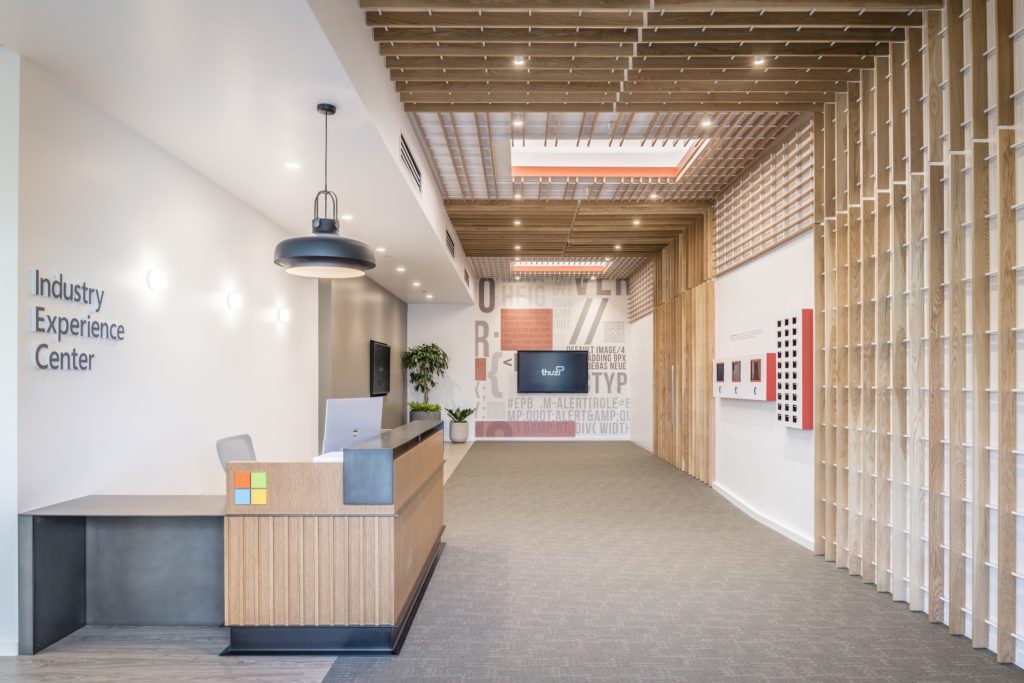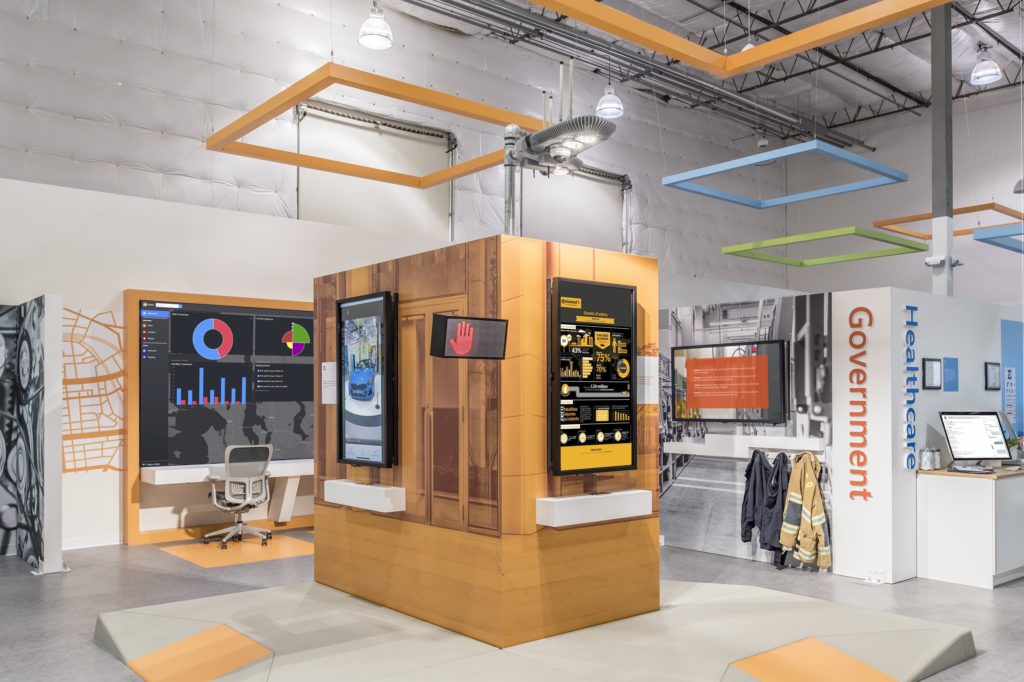
Microsoft’s new Industry Experience Center brings digital transformation to life
We read every day about how companies are transforming their businesses through technologies like artificial intelligence, machine learning, robotics and the Internet of Things. But are these gains achievable across industries? Can a hospital, for instance, really see the same benefits from these technologies as, say, an automotive manufacturer?
Microsoft’s new Industry Experience Center (IEC), which opened last month in Redmond, Washington, aims to answer that question – with a resounding yes. The 23,000-square-foot center showcases 60 fascinating, real-world examples of customers and partners that are innovating their businesses and disrupting markets with Microsoft technologies.
An optical sorter shows how Bühler, one of the world’s largest providers of food processing solutions, is using visual AI to sort out poisonous corn, protecting consumers and increasing production efficiency.

Microsoft’s new 23,000-square-foot Industry Experience Center in Redmond, Washington.
A short distance away, a drone from eSmart Systems buzzes above, dramatically illustrating how machine learning is allowing public utilities to spot problems with power poles without sending a technician out, helping them reduce costs and ensure the safety of their workers.
In the grocery aisle, IoT-enabled displays from Kroger illuminate dynamic pricing and product information based on what the customer touches and looks at on the shelf. Visual analytics automatically alert store staff when an item is out of stock or running low.
“We often talk about technology and services that drive digital transformation, but the IEC is a chance for customers to interact with them firsthand,” says Deb Cupp, CVP of Worldwide Enterprise and Commercial Industries at Microsoft. “These are immersive experiences that demonstrate how companies are digitally transforming, and how our customers and partners are using these solutions to drive disruption in their industries.”

The manufacturing area of the IEC features a compact industrial robot from ABB and an optical sorter from Bühler.
Technology at work in the real world
Each interactive exhibit allows visitors to get hands-on with the technologies and explore how they are being used across industries to drive innovation. Experiences are focused on nine key industries: Retail and Consumer Goods, Financial Services, Education, Government, Health Care, Automotive, Manufacturing, Energy and Media and Communications.
That doesn’t mean a health care company, for instance, will only be guided through health care experiences in the IEC. Instead, Microsoft’s team of full-time “envisioning specialists” take each customer on a customized journey through the most relevant technology solutions for their unique business – no matter what the industry.
RFID wristbands from partner Thuzi – which every visitor gets upon starting their engagement – add to the personalized experience. As customers walk through the center, if they see an exhibit they want to learn more about, they simply tap their wristband against a “puck” on the exhibit wall. They then receive an email with a link to a customized microsite with more information, designed just for them.

Deb Cupp, CVP of Worldwide Enterprise and Commercial Industries.
Cupp says, “Engagements are tailored to each individual customer and designed to spark creative ideation, inspired conversations and new opportunities. With the IEC, customers can get up close and personal with innovative technologies applied across industries so they can envision what’s possible by partnering with Microsoft.”
A showcase for industry innovation
The IEC sits in the same building in what has been, for the last 10 years, the Retail Experience Center. But late last year, the company decided to expand the center to a cross-industry offering to demonstrate the application and breadth of its technology across verticals.
Today, the IEC features everything from first-party Microsoft technologies to solutions created by startups, large global companies and everything in between. Microsoft’s Mixed Reality Capture Studios has installed a state-of-the-art volumetric stage at the IEC where visitors can get a souvenir hologram.
“We’re lighting up innovation by industry across a wide variety of customers and partners all over the globe,” says Cupp.
This benefits the partners that are participating by giving them visibility across a broad and diverse range of customers. Through the IEC, they can show off innovative solutions that they have partnered on with Microsoft. This in turn may scale to Microsoft Technology Centers (MTCs) and Experience Centers (ECs) worldwide for even greater exposure.
The BMW Group, a long-time Microsoft partner, has a showcase at the IEC featuring a BMW Z4 sports car. The experience highlights how Microsoft and BMW are working together to constantly enhance the BMW Intelligent Personal Assistant and its capabilities.
The Microsoft Virtual Assistant Solution Accelerator built on Azure provides the technology framework for the solution, which allows BMW customers to easily perform a variety of tasks simply by talking to the personal assistant, such as arranging an appointment at their preferred BMW dealer.
Featured customers foresee significant benefits from their participation, as well.
Carmen Schlatter, head of Data Analytics & Services at Bühler, says “We’re happy to be participating in the IEC and showcasing our innovative new technologies to improve global food safety and increase transparency and traceability along the food value chain. We have the potential to significantly reduce the human and financial cost of food poisoning worldwide by providing verifiable food safety solutions and linking them with Microsoft blockchain technology.”
Smaller partners like Cooler Screens, a company that IoT-enables retailers’ coolers and turns them into visual, real-time marketing displays, also see the advantages.
“We’re proud to be working with our strategic partner, Microsoft, to reimagine the consumer experience at the retail point of sale,” says Arsen Avakian, CEO and founder of Cooler Screens. “The new IEC will allow us to show retailers and brands how our digital merchandising and media platform can help them delight consumers, build their brands, grow sales, and capitalize on the many advantages of a new age digital retail experience.”

Interactive exhibits are focused on nine key industries, including Government and Health Care.
Envisioning the art of the possible
Microsoft has long had a large portfolio of facilities targeted at the customer’s digital transformation journey. The Redmond Executive Briefing Center (EBC) is a place where thousands of customers come from all over the globe to participate in a white glove, curated experience of business discussions with Microsoft leaders.
The 43 MTCs worldwide host hands-on technical engagements, immersion workshops, hackathons and more. The new ECs, the first of which will launch in Singapore this November, are world-class, regional centers that house a portfolio of programs and capacity for high-touch engagement with customers.
“What we were missing,” says Cupp, “was a facility that was focused on innovation and digital transformation from an industry perspective, where we could bridge the gap between business and technology in an immersive way. The IEC provides that for our customers.”
“At its foundation, the IEC is a partner and customer showcase,” she continues. “These are companies that are bringing to life digital transformation and disruption within their verticals. These are stories that need to be told.”
Top photo: The exhibit from Microsoft partner BMW features a Z4 sports car and highlights the capabilities of the BMW Intelligent Personal Assistant.
The IEC is a private facility that is not open to the public. If you’re interested in scheduling a visit, you may reach out to [email protected].

